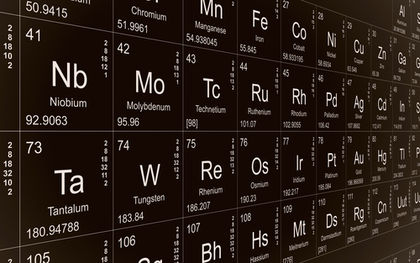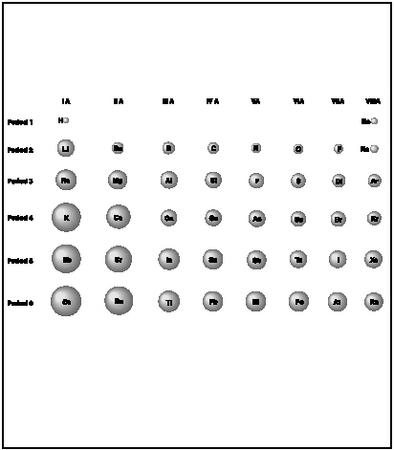Families of Elements - How it works

The Basics of the Periodic Table
Created in 1869, and modified several times since then, the periodic table of the elements developed by Russian chemist Dmitri Ivanovitch Mendeleev (1834-1907) provides a highly useful means of organizing the elements. Certainly other organizational systems exist, but Mendeleev's table is the most widely used—and with good reason. For one thing, it makes it possible to see at a glance families of elements, many of which either belong to the same group (column) or the same period (row) on the table.
The periodic table is examined in depth within the essay devoted to that subject, and among the specifics discussed in that essay are the differing systems used for periodic-table charts in North America and the rest of the world. In particular, the North American system numbers only eight groups, leaving 10 columns unnumbered, whereas the other system—approved by the International Union of Pure and Applied Chemistry (IUPAC)—numbers all 18 columns. Both versions of the periodic table show seven periods.
The groups numbered in the North American system are the two "tall" columns on the left side of the "dip" in the chart, as well as the six "tall" columns to the right of it. Group 1 in this system consists of hydrogen and the alkali metals; Group 2, the alkaline earth metals; groups 3 through 6, an assortment of metals, nonmetals, and metalloids; Group 7, halogens; and Group 8, noble gases. The "dip," which spans 10 columns in periods 4 through 7, is the region in which the transition metals are listed. The North American system assigns no group numbers to these, or to the two rows set aside at the bottom, representing the lanthanide and actinide series of transition metals.
The IUPAC system, on the other hand, offers the obvious convenience of providing a number for each column. (Note that, like its North American counterpart, the IUPAC chart provides no column numbers for the lanthanides or actinides.) Furthermore, the IUPAC has behind it the authority of an international body, founded in 1919, which oversees a number of matters

Despite the international acceptance of the IUPAC system, as well as its merits in terms of convenience, the North American system is generally the one used in this book. The reason, in part, is that most American schools still use this system; furthermore, there is a reasoning behind the assignment of numbers to only eight groups, as will be discussed. Where necessary or appropriate, however, group numbers in the IUPAC system will be provided as well.
Principal Energy Levels
Group numbers in the North American system indicate the number of valence electrons, or the electrons that are involved in chemical bonding. Valence electrons also occupy the highest energy level in the atom—which might be thought of as the orbit farthest from the nucleus, though in fact the term "orbit" is misleading when applied to the ways an electron moves.
Electrons do not move around the nucleus of an atom in regular orbits, like planets around the Sun; rather, their paths can only be loosely defined in terms of orbitals, a pattern of probabilities regarding the areas through which an electron is likely to move. The pattern of orbitals is determined by the principal energy level of the atom, which indicates the distance an electron may move away from the nucleus.
Principal energy level is designated by a whole-number integer, beginning with 1 and moving upward to 7: the higher the number, the further the electron is from the nucleus, and hence the greater the energy in the atom. The relationship between principal energy level and period is relatively easy to demonstrate. The number n of a period on the periodic table is the same as the number of the highest principal energy level for the atoms on that row—that is, the principal energy level occupied by its valence electrons. Thus, elements on period 1 have a highest principal energy level of 1, and so on.
Valence Electron Configurations
When discussing families of elements, however, the periods or rows on the periodic table are not as important as the groups or columns. These are defined by the valence electron configurations, a subject more complicated than principal energy levels—though the latter requires a bit more explanation in order to explain electron configurations.
Each principal energy level is divided into sublevels corresponding to the number n of the principal energy level: thus, principal energy level 1 has one sublevel, principal energy level 2 has two, and so on. As one might expect, with an increase in principal energy levels and sublevels, there are increases in the complexity of the orbitals.
ORBITAL PATTERNS.
The four basic types of orbital patterns are designated as s, p, d, and f. The s shape might be described as spherical, though when talking about electrons, nothing is quite so neat: orbital patterns, remember, only identify regions of probability for the electron. In other words, in an s orbital, the total electron cloud will probably end up being more or less like a sphere.
The p shape is like a figure eight around the nucleus, and the d like two figure eights meeting at the nucleus. Again, these and other orbital patterns do not indicate that the electron will necessary follow that path. What it means is that, if you could take millions of photographs of the electron during a period of a few seconds, the resulting blur of images in a p orbital would somewhat describe the shape of a figure eight.
The f orbital pattern is so complex that most basic chemistry textbooks do not even attempt to explain it, and beyond f are other, even more complicated, patterns designated in alphabetical order: g, h, and so on. In the discussion that follows, we will not be concerned with these, since even for the lanthanides and the actinides, an atom at the ground state does not fill orbital patterns beyond an f.
SUBLEVELS AND ORBITAL FILLING.
Principal energy level 1 has only an s sublevel; 2 has an s and a p, the latter with three possible orientations in space; 3 has an s, p, and d (five possible spatial orientations); and 4 has an s, p, d, and f (seven possible spatial orientations.)
According to the Pauli exclusion principle, only two electrons can occupy a single orbital pattern—that is, the s sublevel or any one of the spatial orientations in p, d, and f —and those two electrons must be spinning in opposite directions. Thus, two electrons can move in an s orbital pattern or shell, six in a p, 10 in a d, and 14 in an f orbital pattern or shell. Valence shell configurations are therefore presented with superscript figures indicating the number of electrons in that orbital pattern—for instance, s 1 for one electron in the s orbital, or d 10 , indicating a d orbital that has been completely filled.
Comment about this article, ask questions, or add new information about this topic: